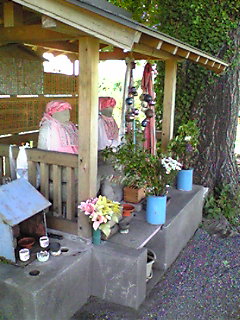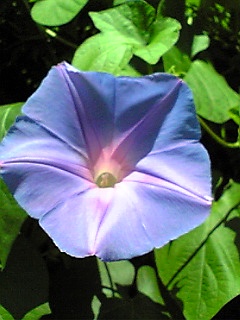August 31, 2009
Every year near the end of summer, memories of the year when
the war ended always return. The summer of 1945, the year of the end of
the war, experienced an extraordinarily long spell of fine weather. Strangely,
I have no recollection of rainy days that year.
I was evacuated to Yoneda in Asakura, my father's hometown, on July 4, the day of the massive air raids of Kochi City. I didn't go to school there; instead, I was engaged in military duties under the Kanto Army. In spite of the military duties, I played with my friends whenever I found time, typical of fun loving junior high school student. For several kilometers along the road between my evacuation home and the place of duties, there were beautiful green paddy fields and crystal clear river, and numerous dragonflies flew over the fields. When I look back, it was almost like a paradise in a dream.
At times, I skipped the duties and spent time with friends
swimming and fishing in a river. Even in tense war-time years, children
had a privilege of having their own fun-filled world. It was while I was
playing with friends that I heard the news of dropping of the atomic bomb
over Hiroshima. Even grave situations taken seriously by adults looked
less serious to children. However, the Kochi Shinbun newspaper reported
the frightening power of the new type of bomb with the large headline:
"Flash! Look out. Take shelter behind an object."
More than 60 years have passed since and I decided to visit
my father's hometown. It has undergone enormous changes. An expressway
runs through the base of the mountain where "specters" were said
to haunt. There are a huge substation and a supermarket in the neighborhood
of our relative's home. There was nothing to remind me of the old days.
There was no trace of my father's birthplace. The river at the foot of
the mountain where numerous fireflies were flying in summer and the squeaking
waterwheel... they were all gone. I found, however, a never-changing stone
statue of deity beside the bank of Kagamigawa River. I would often visit
there with my father. The statue seems to be quietly watching changing
times over many years.

The roadside statues of deity in my father hometown
Kagamigawa River flowing gracefully as it did in those days
gave me the only solace. It was beside this stone statue where my father
pointed out Orion's Belt Stars for me on our way home from the shrine's
autumn festival. The beauty (more aptly awesomeness) of Orion shining over
Akaoniyama mountain was deeply etched in my memory. It was in my second
or third year at elementary school and soon after becoming interested in
natural science intrigued by Mr. Kei Okamoto's teaching, our homeroom teacher.
In those days I was not particularly interested in astronomy,
typical of a boy my age. I read without much attention the news about naked-eye
comets in the Shokokumin Shinbun (a paper for young readers) such as Comet
Cunningham and Comet Okabayashi-Honda, and never thought of throwing myself
into the world of astronomy later.

A rural landscape along Kagamigawa River in my hometown.
August 15, 2009
August 15 is the day to mark the end of the war.
I saw beautiful blue flowers of Asagao (morning glory) in
the garden today. As if exhausted, they wither and turn red by evening
after beaten by harsh summer sun during the day, but next morning they
always bloom vigorously. They are hardy flowers.
A girl living in a big city wrote to me:
"It is touching to see morning glory opening only in fresh morning air. Watching the purplish flower petals, I remembered the color of the ocean seen from my hometown."
Purplish flowers certainly bring back various memories. It
reminds me of the color of the sky over Tosa, where I was sent and spent
time by the student mobilization in 1945, the year the war ended. "Blue
skies and deep-blue waters" was the symbol of Tosa as well as the
catch phrase for its tourism promotion.
In June 1945, Venus was spotted in broad daylight over the
heads of a large number of students who were engaged in military duties
at Inabu, located at the eastern edge of Kochi City. It caused quite a
commotion as they thought it could be an enemy plane. Venus was found immediately
east of the sun because the sky was so clear and deep blue. Needless to
say, they didn't know it was Venus.
After the massive air-raids of Kochi on July 4, we were evacuated
to Yoneda. We didn't go to school; instead, we were engaged in military
duties assisting the Kanto army at Arakurayama nearby. We crossed Kochi
City on an army truck to work at Mt. Hishimayama at the eastern edge of
the city. The city seen from the truck was completely burned down and looked
desolate like a desert. From the bleak, scorched earth, only the national
treasure Kochi Castle and Joto Secondary School buildings were seen intact
and glowing with dignity under the summer sun. I learned the news of the
end of the war up on Hishimayama. Someone overheard the radio broadcast
to tell the end of the war from a house down the hill and told us the news
in a loud voice. Strangely, it was the place where Keizan Kawatani, an
Edo period astronomer, observed a solar eclipse. In 1761, he argued with
the Shogunate's astronomers when he found this solar eclipse was missing
from their almanac. On September 1 the same year, he proved his calculation
of the solar eclipse was correct.
That day, when we learned the end of the war, we walked back
to Asakura, after finishing the day's work, through the scorched land in
a dazed state. We were stunned by the defeat of the country called a "divine
land". The sky over the ruins was filled with grayish air. In fact,
we didn't even see a ray of hope ahead of us. In the midst of the dark
times, my encounter with astronomy was steadily approaching. It was indeed
a fateful encounter.



